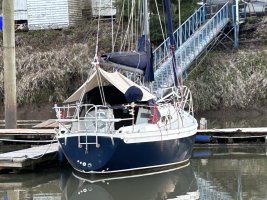Hi Everyone! This is my first post, and I have to say thanks for supporting such a trove of information about Ericsons!
My wife and I have owned a 1985 Ericson 30+ for a few years. Our main question is, "What is the freeboard suppossed to be on a 30+?" I have looked high and low foir this information but can't seem to find it.
We live in Chicago and recently took a trip to South Haven, MI. While motoring back at 5.5 kt, in the middle of the night, we noticed that the stern was very low to the point where the exhaust port was almost in the water. The bilges we complely dry, and when we slowed down the stern came up and the bilge pumps pushed some water out of the back.
Rather than risk a lake crossing, we headed to Benton Harbor / St. Joe for the night. We eventually got a tow back to Chicago. During the tow we were going about 7 kts and the stern was EVEN lower, submerging the exhaust and partially up the ladder. On the dock back home, a neighboring slip suggested that it might be a partially filled or low water ballast. Since my understanding of the 30+ is that it uses the water tank as ballast, I went and checked and the tank was indeed almost empty. Is this what the problem is?
How do I know that I have got the freeboard back to what it should be when sitting in the slip? When sailing or motoring, where should the water line be off the stern? I don't recall ever seeing it be that high before. I haven't gone underneath to see if we are dragging anything.
Thanks for all your help!
My wife and I have owned a 1985 Ericson 30+ for a few years. Our main question is, "What is the freeboard suppossed to be on a 30+?" I have looked high and low foir this information but can't seem to find it.
We live in Chicago and recently took a trip to South Haven, MI. While motoring back at 5.5 kt, in the middle of the night, we noticed that the stern was very low to the point where the exhaust port was almost in the water. The bilges we complely dry, and when we slowed down the stern came up and the bilge pumps pushed some water out of the back.
Rather than risk a lake crossing, we headed to Benton Harbor / St. Joe for the night. We eventually got a tow back to Chicago. During the tow we were going about 7 kts and the stern was EVEN lower, submerging the exhaust and partially up the ladder. On the dock back home, a neighboring slip suggested that it might be a partially filled or low water ballast. Since my understanding of the 30+ is that it uses the water tank as ballast, I went and checked and the tank was indeed almost empty. Is this what the problem is?
How do I know that I have got the freeboard back to what it should be when sitting in the slip? When sailing or motoring, where should the water line be off the stern? I don't recall ever seeing it be that high before. I haven't gone underneath to see if we are dragging anything.
Thanks for all your help!

